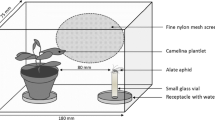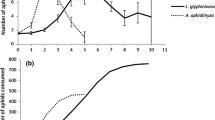Abstract
The abilities of different aphid species to act as vectors of Carrot virus Y(CarVY) in carrots were studied. Their effectiveness at transmitting the virus from infected to healthy carrot plants was compared using 5–10 min acquisition access feeds. With species that colonise apiaceous hosts, the percentage transmission efficiencies found were Myzus persicae: 56; Dysaphis foeniculus: 19; Aphis spiraecola: 17; D. apiifolia: 13; Hyadaphis foeniculi: 7; Cavariella aegopodii: 4; and H. coriandri: 3. With non-colonising species, the respective transmission efficiencies were Lipaphis erysimi: 34; Hysteroneura setariae: 14; Brevicoryne brassicae: 12; Acyrthosiphon kondoi: 10; Sitobion miscanthi: 7; Rhopalosiphum maidis: 2; and R. padi: 0.5. When flying aphids were trapped on vertical nets near to a CarVY-infected carrot planting, 11 out of 101 H. foeniculi caught transmitted the virus to carrot seedlings but the 13 other aphids caught, which belonged to three non-colonising species, did not. If present in sufficient numbers, all 14 aphid species that transmitted the virus have the potential to be important CarVY vectors in carrot crops.
Similar content being viewed by others
References
Berlandier FA, Thackray DJ, Jones RAC, Latham LJ, Cartwright L (1997) Determining the relative roles of different aphid species as vectors of cucumber mosaic and bean yellow mosaic viruses in lupins. Annals of Applied Biology 131, 297–314.
Blackman RL, Eastop VF (1985) ‘Aphids on the world’s crops—an identification guide.’ (John Wiley & Sons: Brisbane)
Bwye AM, Proudlove W, Berlandier FA, Jones RAC (1997) Effects of applying insecticides to control aphid vectors and cucumber mosaic virus in narrow-leafed lupins (Lupinus angustifotius). Australian Journal of Experimental Agriculture 37, 93–102. doi: 10.107 1/EA96041
Clark MF, Adams AN (1977) Characteristics of the microplate method of enzyme-linked immunosorbent assay for the detection of plant viruses. Journal of General Virology 34, 475–483.
Gibbs AJ, Gower JC (1960) The use of a multiple transfer method in plant virus transmission studies—some statistical points arising from the analysis of results. Annals of Applied Biology 48, 75–83.
Halbert SE, Irwin ME, Goodman RM (1981) Alate aphid (Homoptera: Aphididae) species and their relative importance as field vectors of soybean mosaic virus. Annals of Applied Biology 97, 1–9.
Harrington R, Katis N, Gibson RW (1986) Field assessment of the relative importance of different aphid species in the transmission of potato virus Y. Potato Research 29, 67–76.
Irwin ME, Ruesinck WG (1986) Vector intensity: a product of propensity and activity. In ‘Plant virus epidemics: monitoring, modelling and predicting outbreaks’. (Eds GD McLean, RG Garret, WG Ruesinck) pp. 13–33. (Academic Press: Sydney)
Jones RAC (1993) Effects of cereal borders, admixture with cereals and plant density on the spread of bean yellow mosaic potyvirus into narrow-leafed lupins (Lupinus angustifolius). Annals of Applied Biology 122, 501–518.
Jones RAC (2001) Developing integrated disease management strategies against non-persistently aphid-borne viruses: A model programme. Integrated Pest Management Reviews 6, 15–46. doi: 10.1023/A: 1020494604184
Jones RAC (2004) Using epidemiological information to develop effective integrated virus disease management strategies. Virus Research 100, 5–30. doi: 10.1016/j.virusres.2003.12.011
Jones RAC, Latham LJ, Coutts BA (2004) Devising integrated disease management tactics against plant viruses from ‘generic’ information on control measures. Agricultural Science, Australia 17, 10–18.
Jones RAC, Smith LJ, Gajda BE, Latham LJ (2005 a) Patterns of spread of Carrot virus Y in carrot plantings and validation of control measures. Annals of Applied Biology 146, 57–67.
Jones RAC, Smith LJ, Gajda BE, Smith TN, Latham LJ (2005b) Further studies on Carrot virus Y: host range, symptomatology, search for resistance and tests for seed transmissibility. Australian Journal of Agricultural Research 56, 859–868. doi: 10.107 1/AR05028
Latham LJ, Jones RAC (2002) Carrot Virus Y. In ‘Compendium of Umbelliferous Diseases’. (Eds M Davis, R Raid) p. 53. (American Phytopathological Society Press: Minnesota)
Latham LJ, Jones RAC (2004) Carrot virus Y: symptoms, losses, incidence, epidemiology and control. Virus Research 100, 89–99. doi: 10.1016/j.virusres.2003.12.017
Latham LJ, Traicevski V, Persley DM, Wilson CR, Tesoriero L, Coles R, Jones RAC (2004) Distribution and incidence of Carrot virus Y in Australia. Australasian Plant Pathology 33, 83–86. doi: 10.1071/AP03086
McKirdy SJ, Jones RAC (1993) Occurrence of barley yellow dwarf virus serotypes MAV and RMV in over-summering grasses. Australian Journal of Agricultural Research 44, 1195–1209. doi: 10.1071/AR9931195
McKirdy SJ, Jones RAC (1994) Infection of alternative hosts associated with narrow-leafed lupins (Lupinus angustifolius) and subterranean clover (Trifolium subterraneum) by cucumber mosaic virus and its persistence between growing seasons. Australian Journal of Agricultural Research 45, 1035–1049. doi: 10.1071/AR9941035
McKirdy SJ, Jones RAC (1996) Use of imidacloprid and newer generation synthetic pyrethroids to control the spread of barley yellow dwarf luteovirus in cereals. Plant Disease 80, 895–901.
Moran J, van Rijswijk B, Traicevski V, Kitajima EW, Mackenzie AM, Gibbs AJ (2002) Potyviruses, novel and known, in cultivated and wild species of the family Apiaceae in Australia. Archives of Virology 147, 1855–1867. doi: 10.1007/s00705-002-0865-8
Thackray DJ, Jones RAC, Bwye AM, Coutts BA (2000) Further studies on the effects of insecticides on aphid vector numbers and spread of cucumber mosaic virus in narrow-leafed lupins (Lupinus angustifolius). Crop Protection 19, 121–139. doi: 10.1016/S02612194(99)00093-9
Thackray DJ, Diggle AJ, Berlandier FA, Jones RAC (2004) Forecasting aphid outbreaks and Cucumber mosaic virus epidemics in lupin crops in a Mediterranean-type environment. Virus Research 100, 67–82. doi: 10.1016/j.virusres.2003.12.015
Torrance L, Pead MT (1986) The application of monoclonal antibodies to routine tests for two plant viruses. In ‘Developments in applied biology 1: developments and applications on virus testing’. (Eds RAC Jones, L Torrance) pp. 103–118. (Association of Applied Biologists: Wellesborne. UK)
Author information
Authors and Affiliations
Corresponding author
Rights and permissions
About this article
Cite this article
Jones, R.A.C., Smith, L.J., Smith, T.N. et al. Relative abilities of different aphid species to act as vectors of Carrot virus Y . Australasian Plant Pathology 35, 23–27 (2006). https://doi.org/10.1071/AP05092
Received:
Accepted:
Issue Date:
DOI: https://doi.org/10.1071/AP05092




